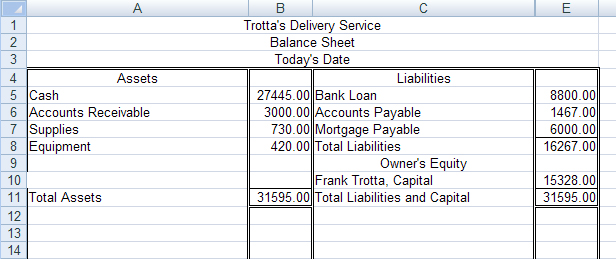Project 1
1. Project 1
1.6. Page 3
Training Room 2: Analyzing Transactions
Time to Practise
Practice 1
To complete this activity, open “Practice 1.”
Practice 2
Part 1: Beginning Balances
Use the following beginning balance sheet:

Microsoft product screen shot(s) reprinted with permission from Microsoft Corporation.
Complete the activity “T-accounts” by indicating the balance side of each. The first one has been done for you.
Part 2: Transactions
Using the T-accounts from Part 1, analyze the transactions in “T-Accounts Practice 2 Part 2,” putting the transaction number beside each amount. The first one has been done for you. Hint: When you have finished, all of the debits should equal all of the credits.
Part 3: New Totals in Accounts
What are the new totals of each account? Notice that total debits should still equal total credits.
Cash
Accounts Receivable
Supplies
Equipment
Bank Loan
Accounts Payable
Mortgage Payable
Frank Trotta, Capital
31770.00
1500.00
730.00
920.00
8150.00
1967.00
5475.00
19328.00
Part 4: Create a New Balance Sheet

© wimpos/12311117/Fotolia
A company does not create a new balance sheet every time a transaction is completed. In fact, a new balance sheet is usually only created at the end of each fiscal period. However, complete one now to see how transactions affect the balance sheet totals.
Notice that the accounting equation remains in balance.
Open Balance Sheet Template and complete a new balance sheet for Trotta’s Delivery Service, using today’s date.
To check your work , go to Trotta's Delivery Service Answer.
You may wish to refer to the Balance Sheet Rubric for a guide to completing your work. This rubric is available for you in the Toolkit to access in the future.
The Balance Sheet Exemplar is available for you to refer to as an example of a completed balance sheet. Exemplars are also available in your Toolkit.